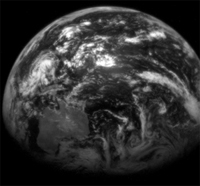NASA's MESSENGER spacecraft, headed toward the first study of Mercury from orbit, swung by its home planet today for a gravity assist that propelled it deeper into the inner solar system.
Mission operators at the Johns Hopkins University Applied Physics Laboratory (APL) in Laurel, Md, say MESSENGER's systems performed flawlessly as the spacecraft swooped around Earth, coming to a closest approach point of about 1,458 miles (2,347 kilometers) over central Mongolia at 3:13 p.m. EDT. The spacecraft used the tug of Earth's gravity to change its trajectory significantly, bringing its average orbit distance nearly 18 million miles closer to the Sun and sending it toward Venus for another gravity-assist flyby next year.
"One flyby down, five more to go," says Mark Holdridge, MESSENGER mission operations manager, of APL. "Now, the mission begins."
Launched Aug. 3, 2004 from Cape Canaveral Air Force Station, Fla., the solar-powered spacecraft is about 581 million miles (930 million kilometers) into a 4.9-billion mile (7.9-billion kilometer) voyage that includes 14 more loops around the Sun. It will fly past Venus twice and Mercury three times before moving into orbit around its target planet. The Venus flybys in October 2006 and June 2007 will use the pull of the planet's gravity to guide MESSENGER toward Mercury's orbit. The Mercury flybys in January 2008, October 2008 and September 2009 help MESSENGER further match that planet's speed, setting up the maneuver in March 2011 that starts a yearlong science orbit around Mercury.
"This Earth flyby is the first of a number of critical mission milestones during MESSENGER's circuitous journey toward Mercury orbit insertion," says Sean C. Solomon, the mission's principal investigator, from the Carnegie Institution of Washington. "Not only did it help the spacecraft sharpen its aim toward our next maneuver, it presented a special opportunity to calibrate several of our science instruments."
MESSENGER's main camera had snapped several approach shots of Earth and the moon over the past week, and today is taking a series of color images, beginning with South America and continuing for one full Earth rotation, that science team members will string into a "movie" documenting MESSENGER's departure. On approach the atmospheric and surface composition spectrometer also made several scans of the moon in conjunction with the camera observations, and during the flyby the particle and magnetic field instruments spent several hours measuring Earth's magnetosphere. The team will download the data and images through NASA's Deep Space Network over the next several weeks, continuing its assessment of the instruments' performance.
MESSENGER will conduct the first orbital study of Mercury, the least explored of the terrestrial ("rocky") planets that also include Venus, Earth and Mars. Over one Earth year - or four Mercury years - MESSENGER will provide the first images of the entire planet and collect detailed information on the composition and structure of Mercury's crust, its geologic history, the nature of its atmosphere and magnetosphere, and the makeup of its core and polar materials.
MESSENGER, short for MErcury Surface, Space ENvironment, GEochemistry, and Ranging, is the seventh mission in NASA's Discovery Program of lower cost, scientifically focused exploration projects. APL designed, built and operates the MESSENGER spacecraft and manages the mission for NASA's Science Mission Directorate.
Media Contacts:
Michael Buckley
Johns Hopkins University Applied Physics Laboratory
(240) 228-7536 or (443) 778-7536
michael.buckley@jhuapl.edu
Dolores Beasley/Erica Hupp
NASA Headquarters, Washington
(202) 358-1753 or (202) 358-1237

Earth loomed large in MESSENGER's field-of-view on July 30, 2005, as the spacecraft approached its home planet for a gravity-assist flyby. The Narrow Angle Camera in MESSENGER's Mercury Dual Imaging System snapped this image, showing clear morning skies over Australia, when the spacecraft was about 655,570 miles (1.05 million kilometers) from Earth. The contrast has been adjusted slightly to bring out the darker features (such as land and water) on Earth's surface.
The flyby on Aug. 2 - during which MESSENGER flew within 1,458 miles (2,347 kilometers) over central Asia - sent the solar-powered NASA spacecraft toward the inner solar system and set up a flyby of Venus in October 2006. MESSENGER, short for MErcury Surface, Space ENvironment, GEochemistry, and Ranging, will fly by Venus twice and Mercury three times before starting an unprecedented, yearlong science orbit around the innermost planet in March 2011.
Credit: NASA/Johns Hopkins University Applied Physics Laboratory/Carnegie Institution of Washington/Northwestern University
Click on the image for a larger version.